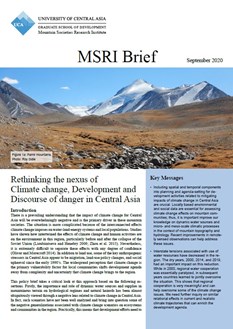Rethinking the Nexus of Climate Change, Development and Discourse of Danger in Central Asia
Abstract
There is growing consensus that the impact of climate change in Central Asia is likely to be overwhelmingly negative, particularly in mountain societies.
The situation is more complicated because of the interconnected effects climate change imposes on water-land-energy systems and local populations. Studies have shown how intertwined the effects of climate change and human activities are on the environment in this region, particularly before and after the collapse of the Soviet Union.
As a consequence, there are problems in the attribution of biodiversity change to different drivers and, therefore, the ability to manage habitats and landscapes appropriately.
In addition to land use, some of the key anthropogenic stressors in Central Asia appear to be migration, land-use policy changes, and social upheaval since the early 1990’s. The widespread perception is that climate change is the primary vulnerability factor for local communities and the uncertainty it brings to the region.








